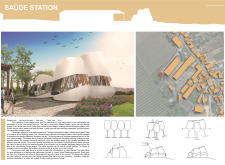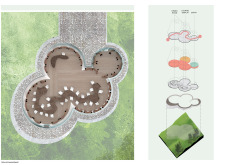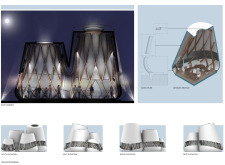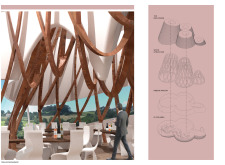5 key facts about this project
This architecture represents a thoughtful response to its surroundings. With its purpose primarily centered on enhancing wine tasting experiences, the design holds significance as a social gathering space for visitors and locals alike. It is a place where the beauty of nature merges seamlessly with the pleasure of savoring wine, making it a hub for entertainment, education, and community interaction.
The architectural design features a series of interconnected spaces, each tailored to support different dimensions of wine tasting. From intimate tasting rooms that foster private conversations to larger communal areas designed for social gatherings, the layout encourages interaction and the sharing of experiences. The strategic arrangement of these spaces emphasizes openness and flow, allowing visitors to transition smoothly from one atmosphere to another while remaining connected to the vineyard landscape.
Visitors will notice that the structure’s form is inspired by elements related to wine, particularly the shape of wine glasses. This design approach results in curved lines and organic shapes that reflect the graceful motion associated with tasting wine. The use of large glass panels amplifies the connection to the outside world, flooding the interior with natural light while offering breathtaking views of the vines beyond. This intentional design choice enriches the sensory experience, allowing guests to appreciate the beauty of the site as they engage with the wine.
The material palette used in this project is equally significant, comprised of glass, wood, concrete, and textured surfaces that come together harmoniously to create a warm and inviting atmosphere. Glass provides transparency and connection to nature, while the wooden elements add warmth and tactile richness. Concrete forms the backbone of the structure, providing stability and enabling the dynamic forms to emerge. Textured surfaces further enhance the overall experience, inviting guests to interact with the architecture on a physical level and deepening their connection with the surrounding environment.
In terms of unique design approaches, this project distinguishes itself by emphasizing sensory engagement. Every element—from the choice of materials to the layout of spaces—serves to enhance the experience of tasting wine. The design acknowledges that wine tasting is not merely about the beverage, but about the overall ambiance and interaction it fosters. By inviting nature into the architecture and breaking down the boundaries between indoor and outdoor spaces, the facility promotes a holistic experience.
Moreover, the integration of outdoor terraces and gardens encourages visitors to immerse themselves in the vineyard setting, adding another layer to the tasting experience. This multifunctional outdoor space not only complements the indoor areas but also helps connect guests with the cultivation of the wines they are tasting.
Through a deliberate consideration of form and function, this architectural project not only fulfills its role as a wine tasting venue but also becomes a cultural landmark within the community. It embodies the local identity through its design and the communal joy of wine tasting, fostering a sense of place and belonging. This project stands as a testament to how thoughtful architecture can enhance cultural practices and contribute to the social fabric of a region.
For those interested in exploring this architectural endeavor in greater detail, further insights can be gained by reviewing architectural plans, architectural sections, and architectural designs presented. Each element has been carefully considered to contribute to the overall success of the project and its capacity to engage visitors in the delightful experience of wine tasting.


























